Counting of marine mammals
There are not many places left on earth where people live by hunting wild animals, and definitely not by hunting the large mammals in the ocean. In many industrialized societies people view this way of making a living with wonder, worry, and downright loathing. Greenland, as is well known, is one of those places where the hunt for seals and whales is very important. But the Greenlandic hunt has been under intensive criticism for a long time, and there are many powerful international organizations which would like to see an end to this way of life. There have been, among other things, numerous claims that Greenland cannot prove that the catches are sustainable, and there have been demands regarding the sizes of the various populations.
An enormous challenge
In order to answer the criticism about the lack of knowledge about Greenland’s whale population, there has, since 2005, been carried out a comprehensive count of all of the important whale populations and walruses in both Eastern and Western Greenland. It was an enormous task which Greenland Institute of Natural Resources had only been able to accomplish with large special grants from the Government of Greenland, and the Danish Department of the Environment through its arctic environment support program DANCEA.
Documented Sustainable Catch
Before 2005, Greenland Institute of Natural Resources only had numbers for a few whale species, and the numbers were often 10-15 years old, and were not nearly adequate to defend the present hunt. Now we have well documented numbers for 10 species of whale (Minke, Fin whale, Humpback, Greenland whale, Pilot Whale, white nose and white sided dolphins, and porpoises). In addition there are three narwhal stocks, and three stocks of walruses. Most of these numbers have been approved by international scientific committees (Such as NAMMCO and IWC) that provide consultation regarding these species. The counts have been conducted from the air, which is expensive, but definitely the best method, as the areas that have to be covered are very large.
Progress for several species
The counts have shown growth in the populations of Humpbacks, Fin whales, Greenland whales, Beluga in Western Greenland, and Narwhal in the Qaanaaq area. The population of Minke, porpoise, white nosed dolphin, and Orca appears to be stable, while the populations of Narwhal in Melville Bay and Eastern Greenland have diminished. Some species are harder to count than others. Minke, for example, are hard to spot from the air, probably because they are often alone, and can only be seen in settled weather without fog, which is very rare.
Scientific analysis of the numbers
Narwhal, Beluga, the Greenland whale, and walruses are good examples of why Greenland cannot simply say how big the populations are. Most of these populations are only present in Greenlandic waters for perhaps a decade, and at other time are in the national waters of other countries. The quality of the count must, for that reason, always be approved by international scientific organizations before the numbers can be used to establish quotas. For the larger whales this is done at the International Whaling Commission (IWC), where a very critical scientific committee carefully evaluates the numbers to determine if they have been properly obtained and analysed. The committee insures that the population numbers have not been over evaluated, and that any uncertainties about the count have not been under evaluated. A similar screening takes place at the North Atlantic Marine Mammal Commission (NAMMCO) regarding the counts for walrus and smaller whales. It can take several years before a number can be approved, and in some cases it is simply impossible to answer the criticism.
Economic impact on Greenland
Greenland needs these numbers so that they can document the sustainability of the various hunts. This is also necessary because trade in items handcrafted from the materials obtained through the hunts are regulated by the Convention on International Trade in Endangered Species of Wild Fauna and Flora (CITES). That organization requires that any hunt or harvest be documented to prove it was done on a sustainable basis. Without the approval of CITES, no tourist can take any item, for example jewellery from walrus, out of the country. One can see on the homepage of the Government of Greenland (Naalakkersuisut) which species can be exported from Greenland.
…And Scientifically
At the same time we can be thankful for the well documented numbers and time series for whale populations well into the future, because the results from the counts can be used to illustrate long term changes in the ecosystem. Whales and walruses are top predators (i.e. the last links in the food chain) and for that reason they can provide a summing up of changes in the food chain and the physical environment (For example ice and temperature conditions).
The method of making aerial counts
Since 1984 there has been a total of 9 visual counts done by airplane, and 2 photographic counts of large whales in Western Greenland. Between 1981 and 2019 there have been 34 aerial counts for Narwhals, Beluga and Walrus in, respectively, Western Greenland, Northwest Greenland, Northeast Greenland, and Eastern Greenland.
Counting from an airplane is far superior to any other method, as one can quickly cover a large area. But safety in flying at low altitudes over ice and ocean must be insured, and for that reason there has been a requirement that airplanes be twin engine, and fitted with extra fuel tanks for increased range, so that alternative landing fields can be used if the intended airport is closed due to bad weather.
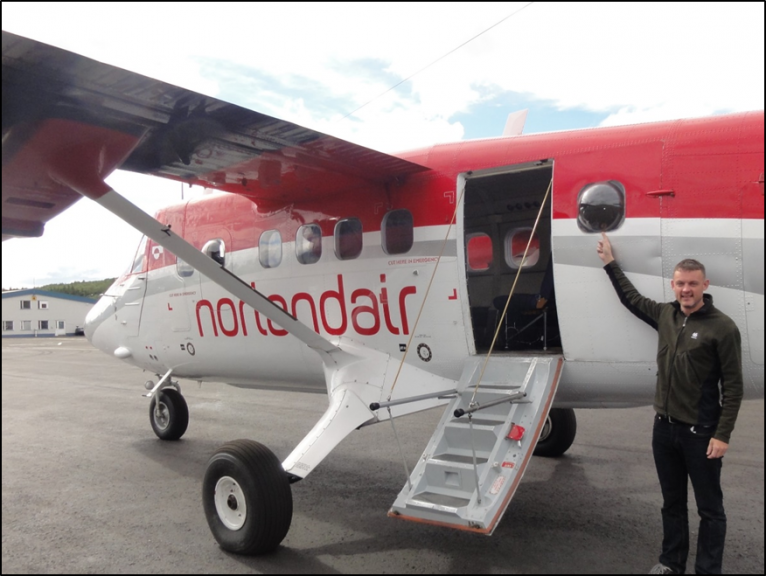
Norlandair’s Twin Otter OY-ATY is ideal for counting marine mammals from the air because it can cover a large area, and has room for 4 observers, which insures a reliable count. Notice the special ”Bubble” windows which replace the standard windows during a count. Photo: R.G. Hansen
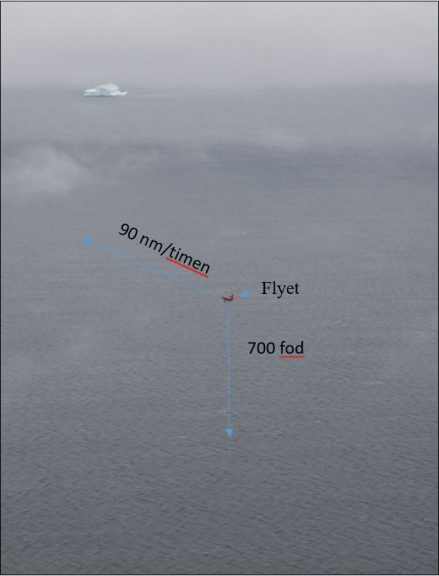
The airplane flies at 90 knots, and 700 feet over the surface of the sea. This gives the observers the chance to see the animals before they dive. Photo: R.G. Hansen
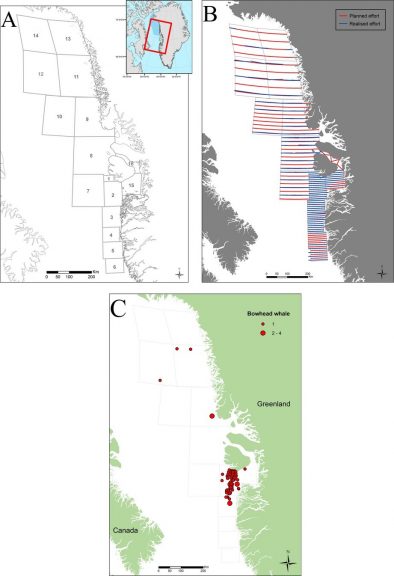
An example of how aerial counting is done. A) shows the different areas which have been planned for over flight. B) shows the lines that were intended to be flight paths (Red stripes), and the actual paths that have been flown (Blue stripes). C) shows the results of the aerial count (This one for Greenland whales). The red dots indicate the number of animals observed.
Type of airplane
Except for one aerial count in 2005, most counts have been done using Air Greenland’s Norlandair Twin Otter OY-ATY. It is a relatively large airplane, which can hold four observers. That makes it possible to conduct a so-called ”Double Observer check.” That allows the crew to find out how many animals had been observed by both observers, in pairs on either side, and how many had only been observed by one observer on that side. This is very important because some of the animals can be difficult to spot, and one must account for the fact that some animals will not be spotted by both observers. Generally speaking, the observers see only 90% of the animals, but by having two observers on each side that number can be improved. This can help to give a more realistic determination of how many animals there were on the surface that the flight is covering. Observers see, for example, almost 100% of white and humpback whales, but only 80% of walruses floating in the water.

Four observers (two in the front and two in the back) make it possible to make corrections for observations made by one or both observers, each on their side of the plane. Photo: R.G. Hansen
Registration and observational equipment
Besides the four observers, who work in pairs without contact with each other, the Twin Otter is also equipped with various registration equipment that can record the plane’s movements, archive counts from the observers, and make a continuous video record of conditions directly under the plane. In addition, the distances to the animals are measured with the help of an electronic angle measurer called a geometer. It is these distances to the animals that are used to develop a so called detection function to evaluate the observer’s ability to see animals at a given distance from the plane. That allows us to take into consideration that animals close to the plane are easier to see than animals farther away.
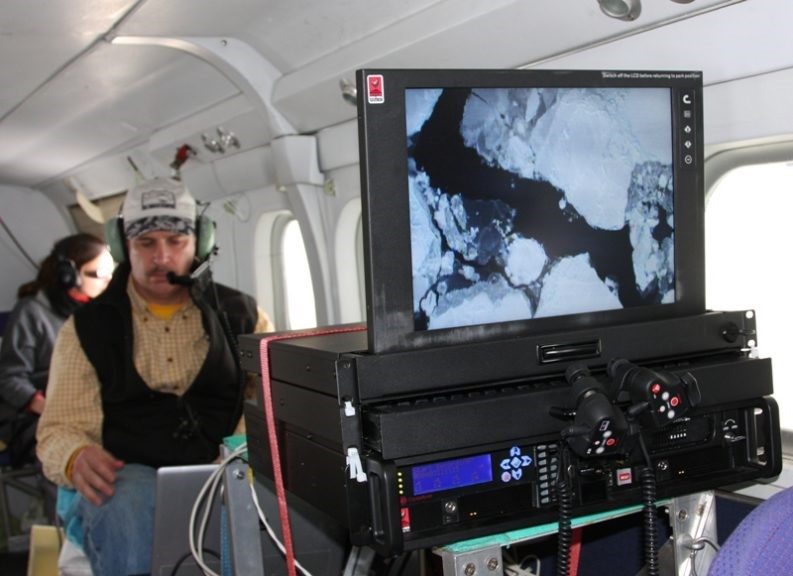
The recording console which records all of the data, as well as taking photos or film of the area directly under the airplane, which the observers might have missed. All of these photos are studied after the aerial count is over, and together with the observed count are used in calculations to determine the size of the population. Photo: MP. Heide-Jørgensen
The console is also used to record animals that the observers might have missed, and to develop a continuous measurement of ice and wind conditions on the surface of the sea. All of the data is entered into a special computer developed by Remote Geosystems.
Bubble windows
And finally, the Twin Otter airplanes are fitted with four bubble windows. These are extra-large hemispherical windows that the observer can actually put his head into so that he can see if there are animals directly under the plane.
Satellite transmitters register diving behaviour
An ongoing problem with counting whales and walrus is that one can always expect that a certain portion of the population will be diving during the over-flight, and for that reason will not be seen by the observers. In order for the count to give a realistic evaluation of how many animals there are in an area, one must make corrections for those animals which cannot be seen. For that reason we use data from animals that have been fitted with satellite transmitters. As a rule they are small pressure sensors that give information about the time that the animal spends on the surface. They record, for example, how much time is spent in 0-2 meters depth, which is the depth that one can expect to spot them in from an airplane.

Satellite transmitter designed to be attached to Narwhals so that researchers can, among other things, follow the wales’ diving behaviour. Photo: MP. Heide-Jørgensen

Satellite transmitter designed to be attached to the fin of a porpoise. Photo: MP. Heide-Jørgensen
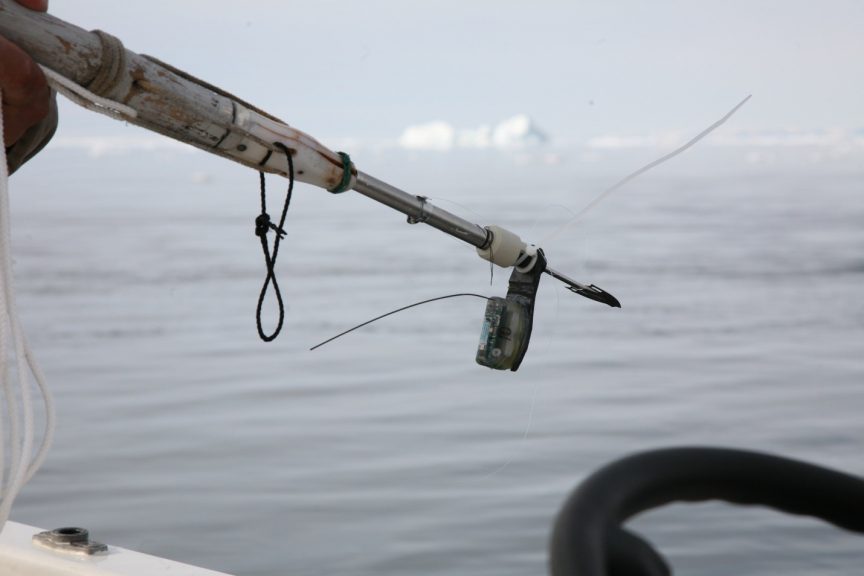
Satellite transmitters for attachment to walrus in the Qaanaaq area. The transmitter is attached to the harpoon, which is then thrown at the walrus with great precision. Photo: N. Nielsen
Large whales in Western Greenland
Minke whales
Greenland has long been criticized for not having a good count of the Minke whale population. That was behind the first aerial counts starting in 1984, which replaced the earlier counts taken from ships, without great success, in 1982 and 1983. Despite the comprehensive efforts it was not until 2007 that it was possible to reach a number that was large enough to justify the hunt for Minke whales in Greenland.
One problem with many of the earlier counts was that the observers saw too few Minkes to enable the use of the models that required large sets of data to be used for calculating the size of a population.
Despite the fact that Minke whales are the most populous of the large whale species in Greenland, they are still almost impossible to find while conducting an aerial count. There have been several theories about how they might have been in sheltered waters while we flew offshore, or the other way around.
The problem is however more likely to be that Minkes are well spread out, and often travel alone. Also, they can only be seen in very settled weather without fog, which is quite rare in Western Greenland.
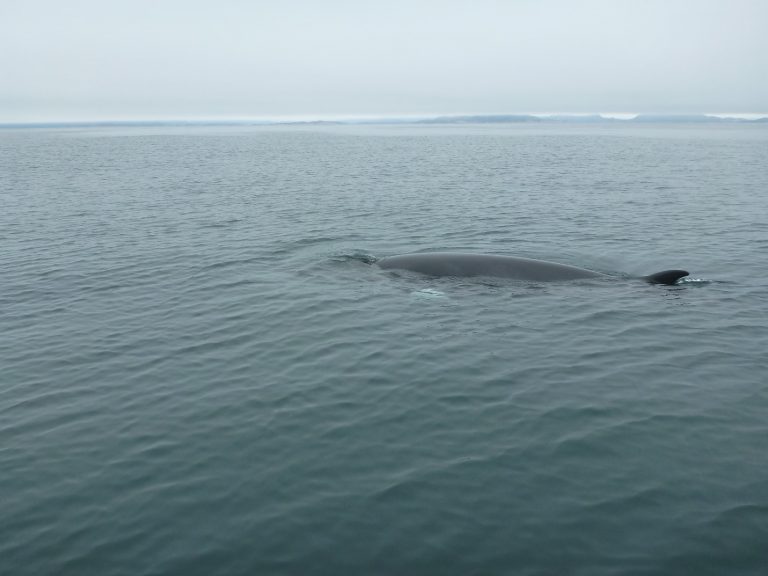
Minke whales often swim alone which makes it difficult to see them during an aerial count. Photo: N. Nielsen
During a count in 2007, and during a follow-up count in 2015, a simpler model was used, one which did not require so many sightings for calculating the size of the population. Due to the problems involved in counting Minke whales it is not possible to say if the population is growing or declining. But the time series from 1984 to 2015 indicates that the numbers vary quite a bit from year to year.
The counting of Minke whales has been a project under development, where it has been necessary to solve a series of problems, through the development of the use of small planes, then to the use of large planes with four observers. It has been an expensive process, but it has given other important results which have helped to raise and focus the efforts on some of the other species.
Fin Whales
A count of Fin whales has been undertaken at the same time as the counting of Minke whales, and it has, technically, been less of a challenge. The Fin whale is one of the largest whale species, and they gather in small groups, which makes it a lot easier to find them as opposed to Minke whales
During recent years it has been possible to attach satellite transmitters to Fin whales in Western Greenland, and the earlier numbers from 2005 and 2007 can, with the help of the data received, be corrected with regard to the time the whales are diving, and therefore not visible to the observers.
The population count for Fin whales for 1987—1988 was at 1100 whales. Comparing that with the new numbers: 9800 animals counted in 2005, and 15,957 in 2007, makes it clear that the population has increased significantly since the 1980’s. From the count taken in 2015 it could be seen that a portion of the population was in East Greenland. Only 2215 animals were found in Western Greenland, while 6440 whales were counted in Eastern Greenland. The quota at present is set at 19 Fin whales.

A herd of Fin whales being counted in 2005. Thanks to their large size, Fin whales are much easier to spot during an aerial count. Photo: L. Witting
Humpback whales
Humpbacks are the only species that we have numbers for during the entire period of making counts. The numbers show an annual growth of 9%, when the number of observations per kilometre flown is compared to the period from 1984 to 2007.
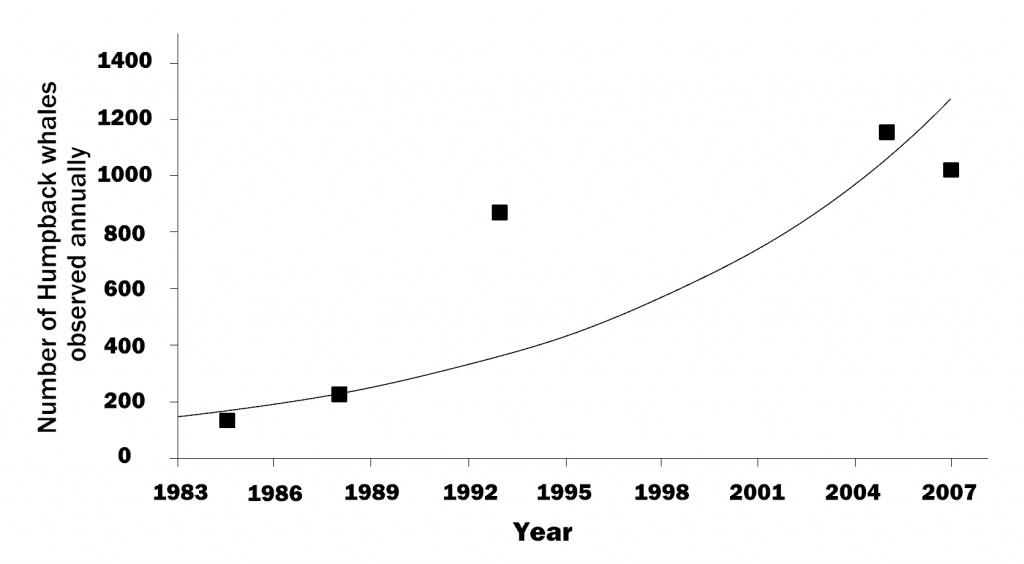
The numbers show that the population of Humpback whales has been growing since the first count. For that reason the IWC has given Greenland a quota of 9 Humpback whales per year.
Growth is in the same order of magnitude as has been seen in other areas of the North Atlantic, and that is to be expected since the protection of the population in Western Greenland, starting in 1985, only a few Humpbacks there have been taken in their winter residence in the Caribbean.

A group of Humpback whales during an aerial count in 2005. Humpbacks are easy to see from the air due to their size and white flippers. Photo: L. Witting
Numbers for whales in Eastern Greenland
For all three baleen whales— Minke whales, Fin whales, and Humpback whales— we have so far not had numbers for their populations along the east coast of Greenland. That changed however with the comprehensive count taken in 2015, which covered both western and eastern Greenland. At that time large numbers of whales, numbers which until then had not been seen, were observed.
In total the count was 2762 Minke whales, 6440 Fin whales, and 4223 Humpback whales. It is not known with certainty if the whales which are found in western Greenland are the same whales that, during some years, travel to eastern Greenland. One satellite tagged Humpback whale was shown, however, to have moved from western Greenland to eastern Greenland in the same year.
Greenland’s ”Problem Children”
The Narwhal, the Beluga, and the Greenland whale have long been seen as Greenland’s ”Problem Children,” because the catch of the Narwhal and the Beluga have, in periods, been too large for the population to tolerate, and the Greenland whale has not shown any sign of growth, despite having been protected for over 100 years.
Around the years 1999-2000 a large number of Greenland whales were unexpectedly observed in Disco Bay. A very careful count in 2006 showed that there were about 1200 whales in the area during the springtime. That count was very advanced, as for the first time it was possible to use satellite tracking for a number of whales, and it was possible to confirm that aerial counts actually did cover the extent of the whales’ habitat. At the same time data on the diving activity of the whales was collected from precisely the same area and time period. A repeat count in 2012 showed that the same number of Greenland whales used Disco Bay as in 2006.

Since the year 2000, hunters from Qeqertarsuaq have worked for Greenland’s Institute of Natural Resources by tagging Greenland whales with satellite transmitters. They are also employed on other projects. Photo: K. Laidre
Beluga
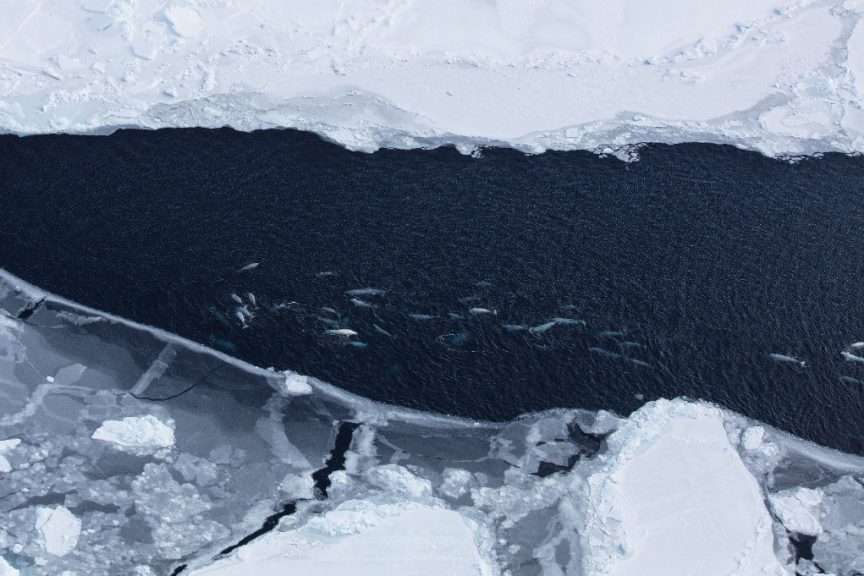
Beluga have been counted in their winter habitat in western Greenland, and in the spring in northern waters. The long series of counts of Beluga go back to 1981, and have shown that the Beluga population is in recovery after a period of large hunts at the end of the 80’s and beginning of the 90’s. The counts also reveal that the Beluga move with the ice, which has moved farther to the west in recent years, which has made it more difficult for hunters to get to them.
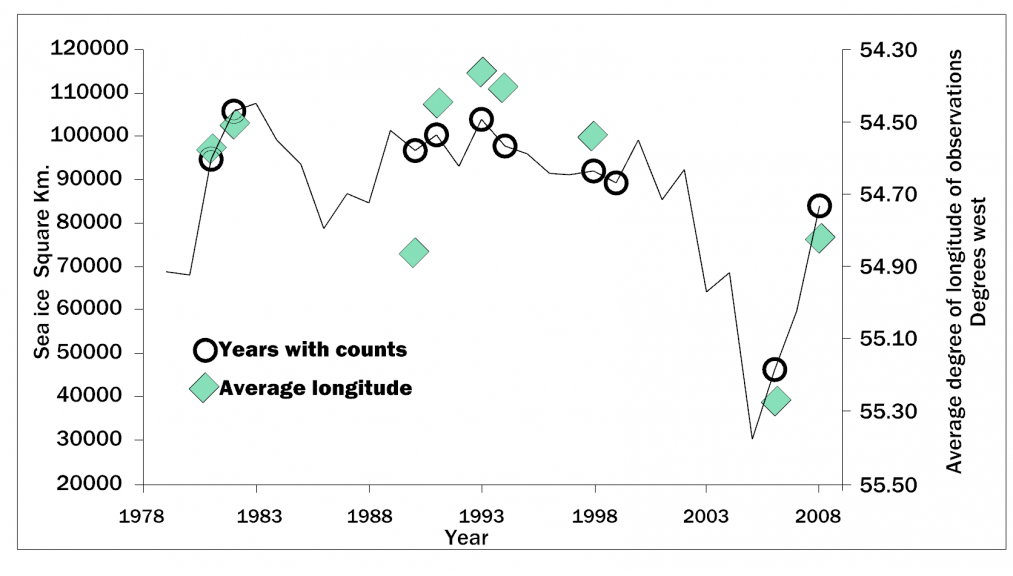
The graph shows how the Beluga follow the edge of the sea ice, and that they are moving westward together with the ice.
Narwhal
Narwhal have been counted in all areas with permanent populations and regular hunts. That is: western Greenland: Inglefield Straits, Melville Bay, north waters, western Greenland, and Disco Bay. However not in Uummannap Kangerlua, where Narwhals spend the winter, and it is too dark for aerial counts. In eastern Greenland, the Narwhal have been counted between Scoresby Sound and Tasiilaq, as well as in Dove Bay and northeast Greenland. Narwhal have been especially well covered because Greenland, together with Canada, has a special responsibility to administer the Narwhal population, as they are the only two countries with large Narwhal populations.
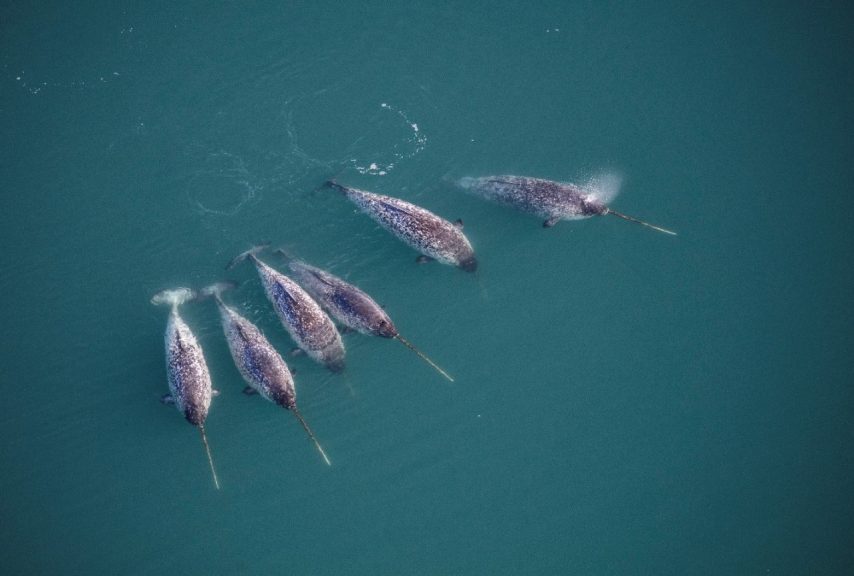
A group of male Narwhal observed during an aerial count. Narwhal are easy to identify from an airplane. Photo: C. Egevang
Walrus
Walrus are also counted from the air, and have been counted in Avannaarsua in the spring of 2013 and 2018. In addition, the population component in western Greenland, in the eastern Baffin Bay and Davis Strait, had been counted in 2006, 2008, 2012, and 2017, and that population appears to be stable.
Smaller whales
Porpoise
There are three small toothed whales that are hunted during the summer in Greenland. There is the Porpoise, the white nosed Dolphin, and the Pilot whale. Porpoise are taken in large numbers (2000-3000 animals annually) in Southwest Greenland, so it is important to have numbers for the size of the population. Porpoise are hard to spot from the air, and that makes it more difficult to conduct an aerial count focused on the large whales. However, it was still possible, in 2007 and 2015, to estimate the Porpoise population to be, respectively, 70,000 and 100,000 animals.
The White nosed Dolphin
We do not know how many White nosed Dolphin are taken each year, but it is probably 200 to 300 annually in southwest Greenland and eastern Greenland. It is believed that the population is large, and probably resides together with Dolphins in other areas of the North Atlantic.
Pilot Whale
Pilot whales are taken on an irregular basis, but sometimes in large numbers of 300 to 400 animals in western Greenland. The species moves over large areas, and the Pilot whales in western Greenland are believed to be part of the northwest Atlantic population.
Pilot whales are generally found in deep water on the western side of banks along western Greenland, and as that area is not well covered by aerial counts, the numbers are considered to be minimum numbers for that population from which the Greenlandic hunt is conducted. Pilot whales are difficult to count because they are often found in very large groups, so called ”super groups,” which makes it difficult to isolate the individual groups.
Killer whales, or Orcas
The only other toothed whale that is hunted in Greenland, and for which there is a lack numbers, is the Killer whale. Despite hundreds of hours of aerial reconnaissance along Greenland’s coast, there have only been a few observations of Killer whale, and for that reason it has not been possible to establish a number for the size of the population. The explanation is probably that there are very few Killer whales around Greenland, and that they move quickly over large areas. So they are only seen locally, but there are not enough of them to be seen from aerial observation, which only covers 5-15% of the surface of the sea.

